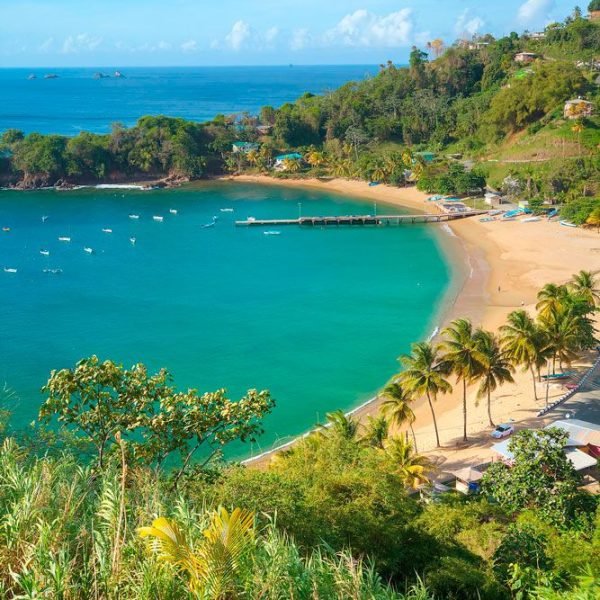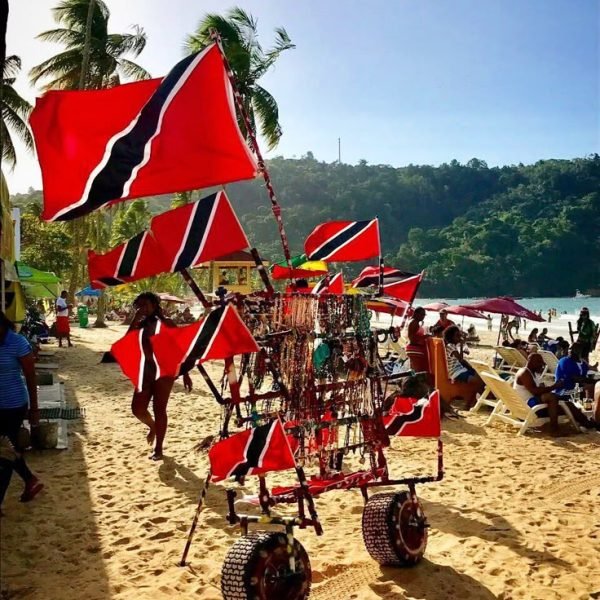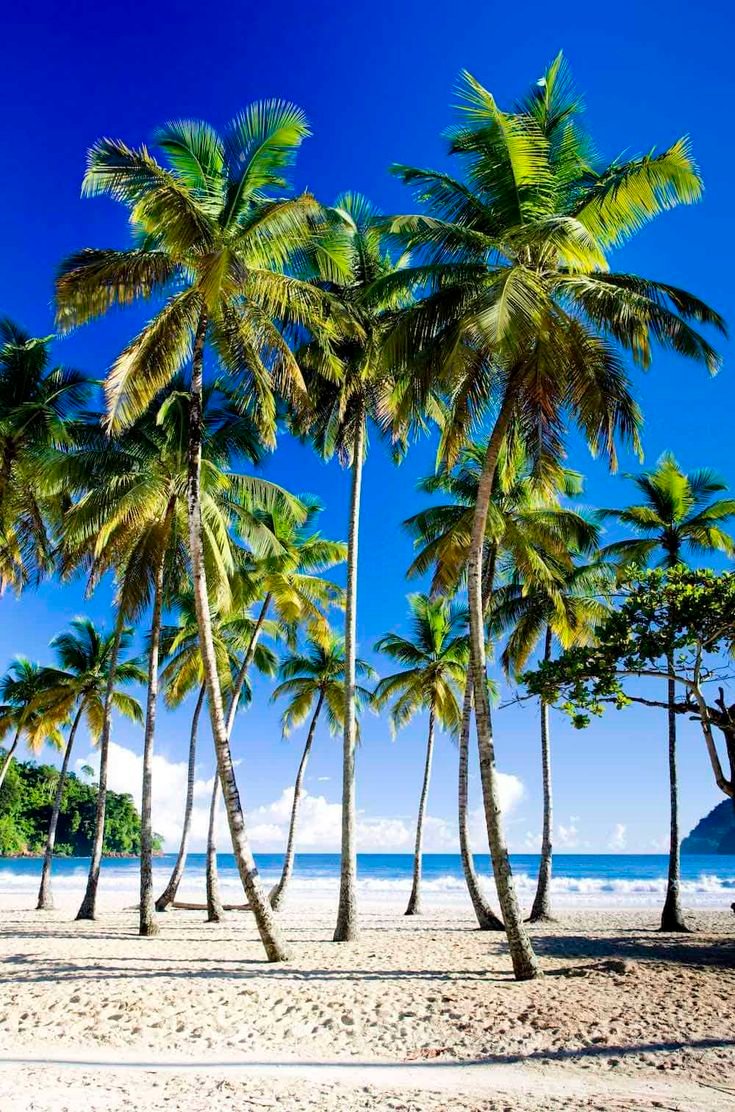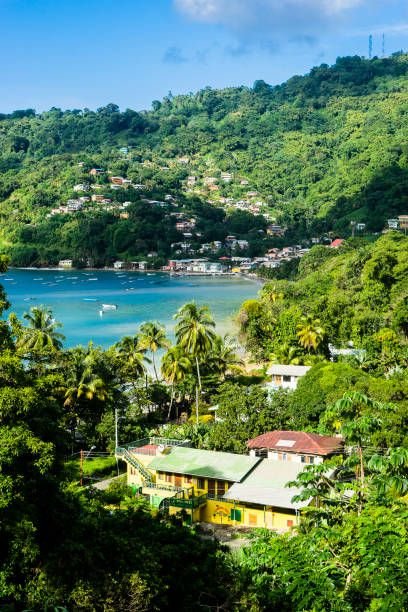Trinidad and Tobago
Welcome to Trinidad and Tobago
Welcome to Trinidad and Tobago, a captivating twin-island republic nestled just off the northeastern coast of Venezuela in the southern Caribbean. Known for its vibrant culture, diverse wildlife, and stunning natural landscapes, Trinidad and Tobago offers an extraordinary blend of experiences that appeal to every kind of traveler-from nature lovers and adventure seekers to culture enthusiasts and beachgoers.
Trinidad and Tobago consists of two main islands that are distinct yet complementary. Trinidad, the larger and more industrialized island, is a bustling cultural hub with a rich history and dynamic urban life centered around its capital, Port of Spain. It boasts tropical rainforests, savannahs, waterfalls, and wetlands that are home to unique wildlife such as howler monkeys, ocelots, manatees, and the famous leatherback turtles. The island’s cultural fabric is woven from African, Indian, European, and indigenous influences, reflected in its music, festivals, and culinary delights.
Tobago, by contrast, is quieter and more laid-back, renowned for its pristine white-sand beaches, coral reefs, and lush rainforests. The island’s natural beauty is showcased in places like the Tobago Forest Reserve-the oldest protected rainforest in the Western Hemisphere-and the Nylon Pool, a shallow white sand area in the sea. Tobago is perfect for eco-adventures, birdwatching, snorkeling, and simply unwinding in nature’s embrace. The country remains relatively underexplored compared to other Caribbean destinations, providing visitors with authentic encounters and less crowded attractions.
Why Visit Trinidad and Tobago?
1.
Unique Natural Wonders
Trinidad and Tobago is home to some of the Caribbean’s most spectacular and varied ecosystems. Visitors can witness the nesting of giant leatherback turtles on remote beaches, hike through tropical rainforests teeming with exotic wildlife, and explore vibrant coral reefs inhabited by manta rays and colorful fish. The islands’ biodiversity is among the richest in the Caribbean, making it a paradise for nature lovers and birdwatchers alike.

2.
Vibrant Culture and Festivities
The islands are a cultural powerhouse, famous for their lively festivals, especially the world-renowned Trinidad Carnival-often considered the greatest street party on earth. Here, music, dance, and elaborate costumes fill the streets with energy and color. Beyond Carnival, the islands offer a rich tapestry of cultural experiences, including steel pan music, calypso, soca, and diverse culinary traditions influenced by African, Indian, European, and indigenous heritage.

Planning Your Trip
Visa Information
Visitors from many countries, including the United States, Canada, the United Kingdom, and EU nations, do not require a visa for short tourist stays in Trinidad and Tobago. However, it is advisable to check the latest visa requirements based on your nationality before traveling, as regulations can change.
Best Time to Visit
The ideal time to visit Trinidad and Tobago is during the dry season, which runs from January to May. This period offers pleasant weather with less rainfall, making it perfect for beach activities, hiking, and exploring the islands. If you want to experience the famous Carnival, plan your trip around February or March, when the festival takes place. The wet season, from June to December, brings more rain and humidity but can be a good time for travelers seeking fewer crowds and lower prices.
Getting To and Around
Getting There
The main international gateway is Piarco International Airport (POS) in Trinidad, which is well connected to major cities in North America, Europe, and other Caribbean islands. Tobago’s A.N.R. Robinson International Airport (TAB) handles regional flights and some international charters. Many visitors arrive via Trinidad and then take a short domestic flight or ferry to Tobago.
Getting Around
In Trinidad, renting a car is the most convenient way to explore the island’s diverse attractions at your own pace. There are also taxis and limited public transportation options. In Tobago, the island is smaller and more relaxed, with taxis and rental scooters commonly used to get around. Local ferries connect the two islands, providing scenic and affordable transport.

Accommodation
The twin islands provide an extensive variety of lodging options, from luxury resorts and boutique hotels to cozy guesthouses and eco-lodges, each offering unique experiences that complement the islands’ vibrant culture and natural beauty.
Trinidad
In Trinidad, visitors can choose from upscale hotels in the capital Port of Spain, convenient airport lodgings, and charming guesthouses scattered across the island. Notable hotels include the Hilton Trinidad & Conference Centre, which offers spacious rooms, beautiful poolside views, and excellent amenities such as tennis courts and a gym. It’s praised for its blend of nature and cityscape, making it a comfortable base for both business and leisure travelers. The Courtyard by Marriott Port of Spain is another popular choice, known for its friendly staff, clean rooms, and proximity to the city’s entertainment district. For those seeking a more intimate stay, guesthouses like Kiskadee Korner and Pax Guest House provide cozy, safe accommodations with personalized service, ideal for travelers wanting a homely atmosphere.
For travelers with layovers or early flights, Piarco Village Suites and Airport Inn Ltd offer practical, comfortable options near Piarco International Airport, with amenities like included breakfast and easy airport transfers. Eco-conscious visitors often opt for places like Leatherback Lodge Eco B&B, which combines comfort with access to Trinidad’s rich wildlife and nature excursions.
Tobago
Tobago’s accommodations lean more towards beachfront resorts, boutique hotels, and charming inns that emphasize relaxation and nature. The Blue Haven Hotel at Bacolet Bay is a standout, offering ocean-view rooms, an outdoor pool, and attentive service that makes guests feel pampered. Viola’s Place in Lowlands is beloved for its cozy rooms, inviting pool, and proximity to local groceries and eateries, perfect for families and longer stays.
For a more rustic and intimate experience, Castara Inn provides air-conditioned rooms with stunning views and direct access to a quiet beach, surrounded by lush fruit trees and a welcoming local community. Comfort Inn & Suites Tobago offers modern amenities including a fitness center and free shuttle service, ideal for travelers seeking convenience and comfort.
Across both islands, there are options ranging from budget-friendly guesthouses to luxury lodges, ensuring every traveler can find a suitable place to rest after a day of exploring.

Food and Drink
The culinary scene in Trinidad and Tobago is as vibrant and diverse as its culture, reflecting a rich fusion of African, Indian, European, Chinese, and indigenous influences. Food here is a celebration of bold flavors, fresh ingredients, and traditional cooking methods.
Trinidad
In Trinidad, street food and local markets are a must-try for authentic tastes. Popular dishes include doubles-a beloved street snack of curried chickpeas sandwiched between two fried flatbreads-roti filled with curried meats or vegetables, and bake and shark, a savory fried shark sandwich served with various toppings and sauces, especially popular at Maracas Bay.
The island’s Indian heritage shines through in dishes like curry chicken, aloo pie (fried pastry filled with spiced potatoes), and pelau, a one-pot rice dish cooked with pigeon peas, meat, and coconut milk. Seafood lovers will enjoy fresh catches prepared in Creole or Caribbean styles, often accompanied by callaloo, a leafy green vegetable stew.
Trinidad’s vibrant nightlife and entertainment districts, particularly around Port of Spain, offer a range of dining options from casual eateries to upscale restaurants serving international and fusion cuisine. The island is also famous for its street vendors selling sweet treats like coconut ice and sugar cakes.
Tobago
Tobago’s food scene is more laid-back but equally flavorful, with an emphasis on fresh seafood and traditional island fare. Grilled fish, crab and dumplings, and curried goat are staples. Many beachside shacks and local restaurants serve dishes infused with local herbs and spices, offering a taste of authentic Tobagonian hospitality.
Tobago is also known for its homemade rum and locally brewed beers, which pair perfectly with the island’s spicy and savory dishes. Visitors can enjoy tropical fruit juices and cocktails made with fresh island fruits like mango, guava, and passion fruit.
Drinks and Nightlife
Both islands boast lively nightlife scenes, especially Trinidad during Carnival season, where music, dance, and street parties abound. Bars and clubs serve a variety of drinks, including the national favorite, rum punch, and other tropical cocktails. The steel pan music scene adds a unique soundtrack to evenings out, enhancing the festive atmosphere.

Must-See Attractions
- Maracas Beach (Trinidad)
Maracas Beach is arguably Trinidad’s most famous and picturesque beach, located about a 40-minute drive from Port of Spain along the scenic North Coast Road. With its powdery white sand, swaying palm trees, and crystal-clear turquoise waters, it epitomizes the Caribbean beach dream. The beach is well-equipped with facilities and vibrant local vendors selling the island’s iconic shark sandwiches, a must-try culinary delight. Beyond sunbathing and swimming, the drive itself offers spectacular rainforest views, making the journey part of the experience. Maracas Beach is a lively spot where locals and tourists mingle, creating a festive and welcoming atmosphere. - Asa Wright Nature Centre (Trinidad)
For nature lovers, the Asa Wright Nature Centre is a top destination. This renowned bird sanctuary and nature reserve offers guided tours through verdant trails, where visitors can spot exotic birds like the oilbird and the elusive hummingbirds. The historic Great House on the property serves Caribbean-inspired meals, allowing guests to dine surrounded by lush greenery and the sounds of wildlife. It’s a perfect place to immerse yourself in Trinidad’s rich biodiversity and experience its tropical rainforest ecosystem firsthand. - La Brea Pitch Lake (Trinidad)
Known as the largest natural asphalt lake in the world, the La Brea Pitch Lake is a geological marvel covering about 100 acres. Located in southwest Trinidad, this “eighth wonder of the world” is a bubbling, sticky expanse of pitch that has intrigued scientists and visitors alike for centuries. Walking tours allow visitors to explore the lake’s unique surface, which is firm yet malleable, and learn about its formation and the microorganisms that thrive there. It’s a surreal and educational experience unlike any other. - Caroni Swamp Bird Sanctuary (Trinidad)
The Caroni Swamp is a vital mangrove wetland and a sanctuary for wildlife, especially the striking Scarlet Ibis, Trinidad and Tobago’s national bird. From November to March, flocks of these brilliant red birds return to roost at sunset, painting the sky with dazzling color. Guided boat tours through the swamp’s serene waterways provide close encounters with a variety of birds, fish, and reptiles, including crocodiles. The Caroni Swamp offers a peaceful escape into nature and is a highlight for birdwatchers and eco-tourists. - Queen’s Park Savannah and the Magnificent Seven (Trinidad)
Located in the heart of Port of Spain, Queen’s Park Savannah is a large open space popular for recreation and cultural events. Surrounding the Savannah is the “Magnificent Seven,” a row of seven grand colonial-era mansions showcasing stunning architecture. The Savannah itself hosts festivals, sports, and Carnival events, making it a cultural hub. Nearby attractions include the Emperor Valley Zoo and the Royal Botanic Gardens, perfect for a leisurely day exploring the city’s green spaces. - Buccoo Reef and Nylon Pool (Tobago)
Tobago’s Buccoo Reef is one of the Caribbean’s most spectacular coral reefs, renowned for its vibrant marine life and crystal-clear waters. Snorkeling and glass-bottom boat tours allow visitors to admire colorful fish, corals, and underwater formations. Nearby, the Nylon Pool is a shallow, sandy area in the middle of the sea with stunning turquoise water, perfect for swimming and relaxing. This natural “pool” feels like a magical oasis and is a must-visit for beach and ocean lovers. - Argyle Waterfall (Tobago)
Argyle Waterfall is Tobago’s tallest waterfall, cascading approximately 175 feet through lush rainforest. A popular hiking destination, the trail to the falls offers an immersive experience in the island’s tropical ecosystem, complete with the sounds of birds and flowing water. The waterfall’s refreshing pool at the base is perfect for a swim, making it a rewarding stop for nature enthusiasts and adventure seekers. - Fort King George Heritage Park (Tobago)
This historic fort offers panoramic views of Scarborough, Tobago’s capital, and the Caribbean Sea. Fort King George is a window into the island’s colonial past, featuring preserved cannons, a museum with artifacts, and beautifully maintained grounds. It’s a great spot for history buffs and those wanting to combine culture with scenic vistas.

Must-Do Activities
- Experience Trinidad Carnival
Trinidad Carnival is often hailed as the world’s greatest street party. Held annually on the Monday and Tuesday before Ash Wednesday, this vibrant festival features colorful costumes, pulsating soca and calypso music, energetic dance, and lively parades. Participating in or witnessing Carnival is a once-in-a-lifetime experience that immerses visitors in the island’s rich cultural heritage and joyous spirit. Even outside Carnival season, you can explore the music, dance, and arts that define this iconic event. - Birdwatching and Wildlife Tours
Both islands offer exceptional opportunities for birdwatching and wildlife encounters. Besides the Caroni Swamp, the Asa Wright Nature Centre is a hotspot for spotting rare birds and tropical wildlife. Early morning guided walks reveal the islands’ diverse fauna, from hummingbirds to howler monkeys. Nature lovers should also explore the Tobago Forest Reserve, the oldest protected rainforest in the Western Hemisphere. - Snorkeling and Diving
The underwater world of Trinidad and Tobago is spectacular. Buccoo Reef in Tobago is the premier snorkeling and diving site, with crystal-clear waters and abundant marine life. Other popular dive spots include Speyside and Little Tobago Island, where you can explore coral gardens, underwater caves, and encounter turtles, rays, and reef fish. For beginners and experts alike, the islands offer unforgettable aquatic adventures. - Hiking and Waterfall Exploration
The islands’ lush landscapes are perfect for hiking. Trails range from easy walks to more challenging treks through rainforests and hills. Highlights include the hike to Argyle Waterfall in Tobago and the trails around the Asa Wright Nature Centre in Trinidad. These hikes provide a chance to connect with nature, spot wildlife, and enjoy stunning scenery. - Visit Local Markets and Taste Street Food
Exploring local markets such as Port of Spain’s Queen’s Park Savannah area and San Fernando’s markets offers a sensory feast. Sample street foods like doubles (curried chickpeas in fried flatbread), bake and shark, and various roti dishes. These vibrant markets are also great places to buy local crafts, spices, and souvenirs. - Boat Tours and Island Hopping
Take boat trips to explore smaller islands and secluded beaches. The “Down D Islands” off northwest Trinidad, including Gasparee Caves, offer snorkeling, cave exploration, and peaceful beaches. Ferry rides between Trinidad and Tobago provide scenic views and easy access to both islands’ attractions. - Cultural and Historical Tours
Explore the rich history of the islands through visits to sites like Fort King George, the Magnificent Seven mansions, and the Tobago Museum. Learn about indigenous peoples, colonial history, and the islands’ path to independence. Cultural tours often include visits to steel pan workshops and art galleries.

Travel Tips
Traveling to Trinidad and Tobago in 2025 promises an enriching experience filled with vibrant culture, stunning natural beauty, and warm hospitality. However, like many destinations, it requires travelers to be mindful of safety, respectful of local customs, and familiar with basic language nuances to ensure a smooth and enjoyable visit. Here’s a comprehensive guide with essential travel tips covering safety advice, local customs, and language basics.
Safety Advice
While Trinidad and Tobago is a beautiful destination, it is important to exercise caution, especially regarding personal safety and security.
Crime and Personal Safety
The country experiences a relatively high level of violent crime, particularly in certain areas of Trinidad such as parts of Port of Spain, Laventille, Morvant, and Barataria. Gang-related violence, armed robberies, carjackings, and assaults have been reported, so travelers should be vigilant at all times. Tobago generally has a lower crime rate, but petty crimes and occasional violent incidents can still occur.
To reduce risks:
- Avoid walking alone at night, especially in poorly lit or remote areas. Stick to well-populated, well-lit streets.
- Do not display expensive jewelry, watches, cameras, or large amounts of cash that might attract unwanted attention.
- Always secure your belongings and avoid leaving drinks or food unattended, particularly in bars, nightclubs, and crowded events.
- Use only official, licensed taxis or transportation recommended by your hotel or trusted locals. Avoid accepting rides from strangers or unregistered vehicles.
- When driving, keep windows closed and doors locked, and avoid stopping for minor car issues on isolated roads.
- Be cautious when using online dating apps or social media to meet locals; arrange meetings in public places and inform someone of your plans.
- If confronted by criminals, cooperate and do not resist to avoid escalation. Your safety is paramount.
Transportation Safety
Road conditions on major highways are generally good, but rural roads can be narrow, poorly maintained, and unlit at night. Driving habits may be unpredictable, with some drivers not strictly following traffic laws. Avoid driving at night if possible, and always wear seatbelts. If renting a vehicle, ensure you have the proper permits and insurance, including an International Driving Permit if required.
Public transportation can be crowded and chaotic. Maxi taxis (shared vans) are common but can be unpredictable. For safety, wait for transport in well-lit areas and sit near the driver. Avoid riding motorcycles or motorbike taxis, which have a higher accident risk.
Health and Medical Precautions
There are no major health advisories currently, but travelers should take standard precautions:
- Stay hydrated and carry bottled water, especially during the dry season when water shortages can occur.
- Protect yourself from mosquito bites to avoid diseases such as dengue, chikungunya, and Zika virus. Use insect repellent and wear long sleeves in the evenings.
- Avoid swimming alone or after dark, and heed local advice about safe swimming areas due to possible riptides and occasional shark sightings.
- Use reputable tour operators for adventure activities like hiking, diving, and boating, and ensure you have adequate travel insurance covering these activities.
Emergency Contacts
In case of emergencies, dial 999 for police, 990 for fire services, and 811 or 990 for ambulance services. It’s advisable to keep these numbers handy throughout your trip.
Local Customs
Understanding and respecting local customs will enrich your travel experience and help you connect with the people of Trinidad and Tobago.
Friendly and Warm Culture
Trinidadians and Tobagonians are known for their warmth, friendliness, and hospitality. A polite greeting and a smile go a long way. It’s common to greet people with a “Good morning,” “Good afternoon,” or “Good evening” when entering shops, restaurants, or meeting locals.
Dress Code
Casual, lightweight clothing is suitable for the tropical climate. However, modest attire is appreciated in religious sites and rural communities. For nightlife or upscale dining, smart casual wear is generally expected.
Respect for Festivals and Traditions
Carnival is the most famous cultural event, and while it’s a time of exuberant celebration, it’s important to respect the customs and the people participating. Photography is usually welcome but ask permission before taking close-up photos of individuals, especially during religious or private ceremonies.
Tipping
Tipping is customary but not mandatory. In restaurants, a 10-15% tip is appreciated if service is not included. Taxi drivers and hotel staff also appreciate small tips for good service.
Social Etiquette
- Avoid controversial topics such as politics or crime unless you know the person well.
- Public displays of affection are generally accepted, but excessive behavior might attract attention.
- It’s polite to accept food or drink offered by hosts, but if you decline, do so graciously.
Language Basics
English is the official language of Trinidad and Tobago, making communication straightforward for English-speaking travelers. However, the islands have a rich linguistic culture with unique expressions and accents.
Standard English
You will find that all official signs, menus, and services are in English. Most locals speak English fluently, especially in urban areas and tourist centers.
Trinidadian and Tobagonian Creole
Locals often speak in a lively and melodic form of English known as Trinidadian Creole or Tobagonian Creole. This dialect includes unique vocabulary, idiomatic expressions, and a distinctive rhythm. Here are some common phrases you might hear:
- “Wha’ happenin’?” – What’s happening? / How are you?
- “Lime” – To hang out socially or relax with friends.
- “Macco” – A person who is nosy or meddles in others’ business.
- “Small up yuhself” – Make room or move over.
- “Doh” – Don’t.
- “Maco” – Someone who gossips or is overly curious.
Using a few local phrases can endear you to residents and enhance your cultural experience.
Politeness and Tone
Trinidadians and Tobagonians appreciate politeness and a friendly tone. When asking for directions or assistance, a warm greeting and “please” and “thank you” are always welcomed.
Final Tips for a Smooth Journey
Traveling safely in Trinidad and Tobago involves staying alert, avoiding risky areas especially after dark, and using trusted transportation. Respecting local customs and engaging warmly with the people will enrich your visit, while knowing some local language nuances can make interactions more enjoyable. With these tips in mind, you can confidently explore the islands’ vibrant culture, breathtaking nature, and unforgettable experiences while staying safe and respectful throughout your journey.

